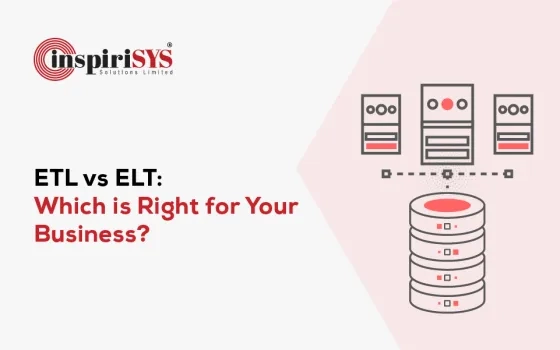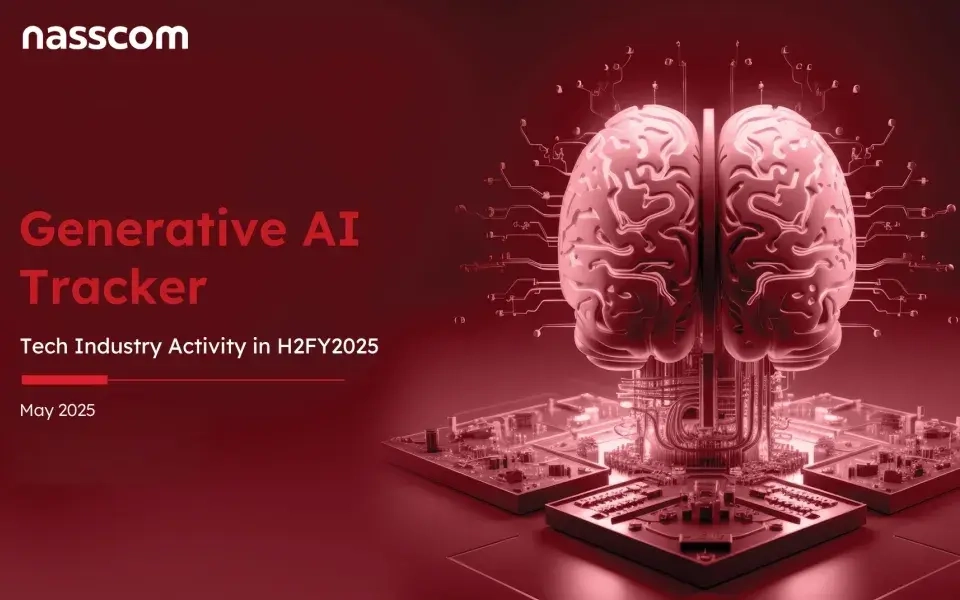The world of technology undergoes constant transformations and faces common hurdles in businesses.
One of the major challenges encountered by organisations when building a pipeline is selecting the best data integration method. Understanding the types of data integration, their primary differences and their impact on the organization is crucial. The common types of data integration are ELT and ETL which have different sets of scalability, functionalities and performance.
According to MarketsandMarkets statistics, the global data integration market was valued at USD 11.6 billion in 2021 and is expected to grow at a CAGR of 11% from 2021 to 2026, with projected revenue reaching USD 19.6 billion in 2026.

Let’s start by discussing the basics.
Exploring the Essential Guide to ETL
In simple terms, the ETL method refers to Extract, Transform, and Load. This procedure involves collecting information from various sources, preparing these sources for the analysis process, and then stocking it in the data storage system. ETL is regarded as a traditional approach as it is used to store data. ETL method has been used by organizations for more than a decade and has evolved as a target database as well as a data source.
ETL Workflow – The Working Process
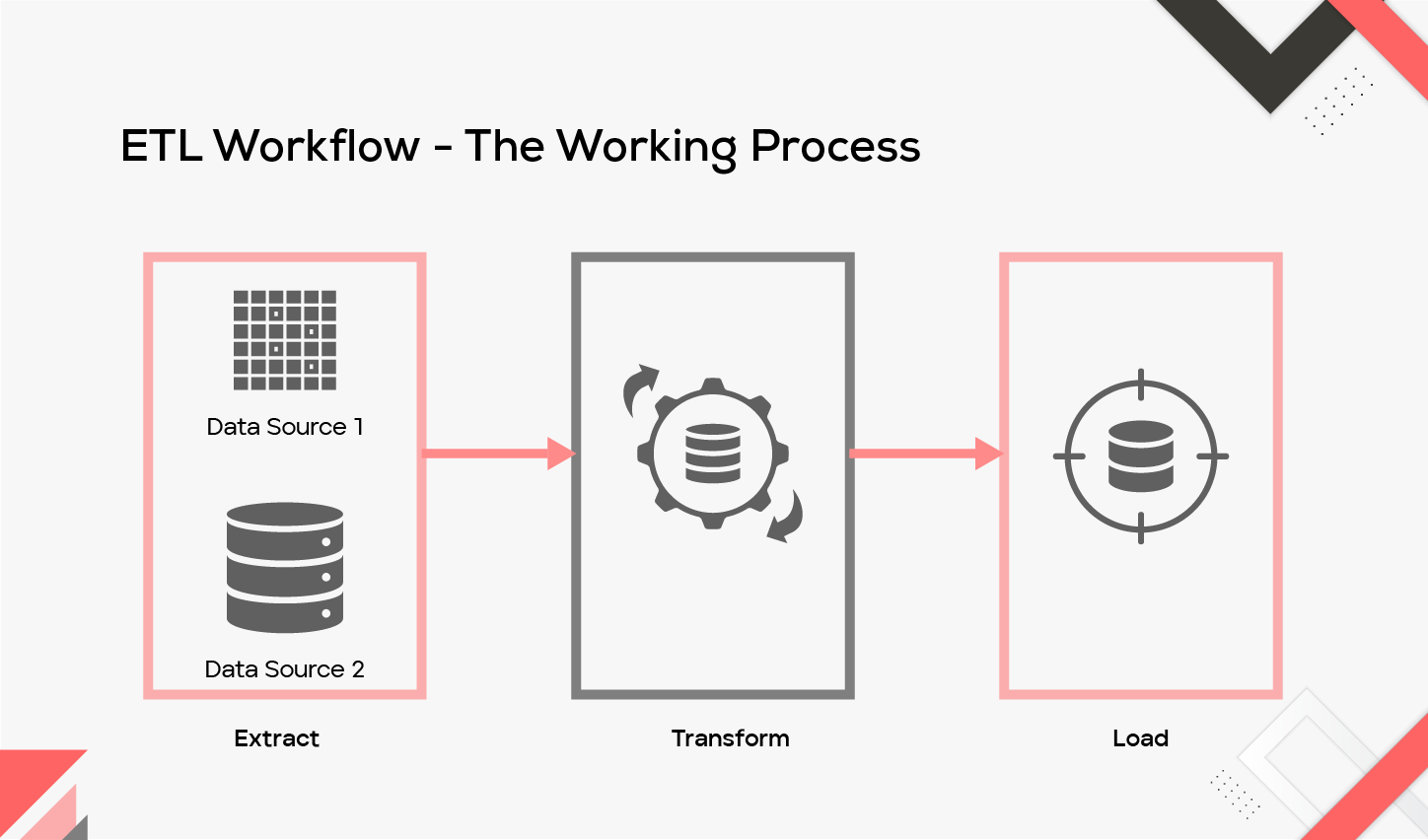
Let’s now understand the working process of ETL in detail:
1. Extract
The first stage is the extraction process, where the raw data is extracted through several sources and shifted to a staging area. These data can be extracted from different sources:
- Emails
- Web Pages
- Databases
- Flat Files
2. Transform
The collected raw data types from various sources undergo data processing and get converted into a conventional style. By doing so, it is ensured that data is sent to the target warehouse in a way that makes it easy to evaluate and use for business decision-making.
The following tasks could be included in the phase:
- Filtering the data, cleaning and sorting
- Executing audits to keep an eye on data accuracy
- Removing the unnecessary data that is managed by the industry
- Modifying the tables and rows to follow uniformity
3. Load
The final phase in this process involves carrying the converted data to the target data warehouse. This stage often includes:
- Data loading
- Data updates at constant intervals
- Refreshes to replace the data in the warehouse
Organizations that employ ETL often have this process automated, and well-defined.
Advantages of ETL for Business
Using the ETL approach can help create business intelligence from massive amounts of data that are obtained from various sources and new growth opportunities are gained through valuable insights.
Let’s now explore the advantages of the ETL process:
1. Increased Security
ETL removes sensitive data and modifies the data before the loading process. Consequently, business receives an additional level of security.
2. Advanced Environment
Since ETL has been around the corner for nearly two decades, tools and infrastructure are supporting them greatly. Thus, with these available facilities, it is easier for the organization to implement ETL.
3. Reduced Storage Costs
Since, ETL stores only pre-structured data, the storage capacity gradually decreases. This enables organizations to save a significant amount by avoiding expenses on storage solutions.
The Ultimate Guide to ELT
The more recent way to connect data is through the ELT technique. The ELT data integration, which stands for Extract, Load, and Transform, involves moving raw data to a target resource like a data warehouse. Although both processes might look similar, the entire processing approach is fundamentally different.
The processing power of modern data warehousing solutions, like the data lakes, is used by ELT during the load phase to transform new data. Thus, no distinct space for separate transformation is needed. Further, ELT can be used to handle large amounts of data.
ELT Workflow – The Working Process
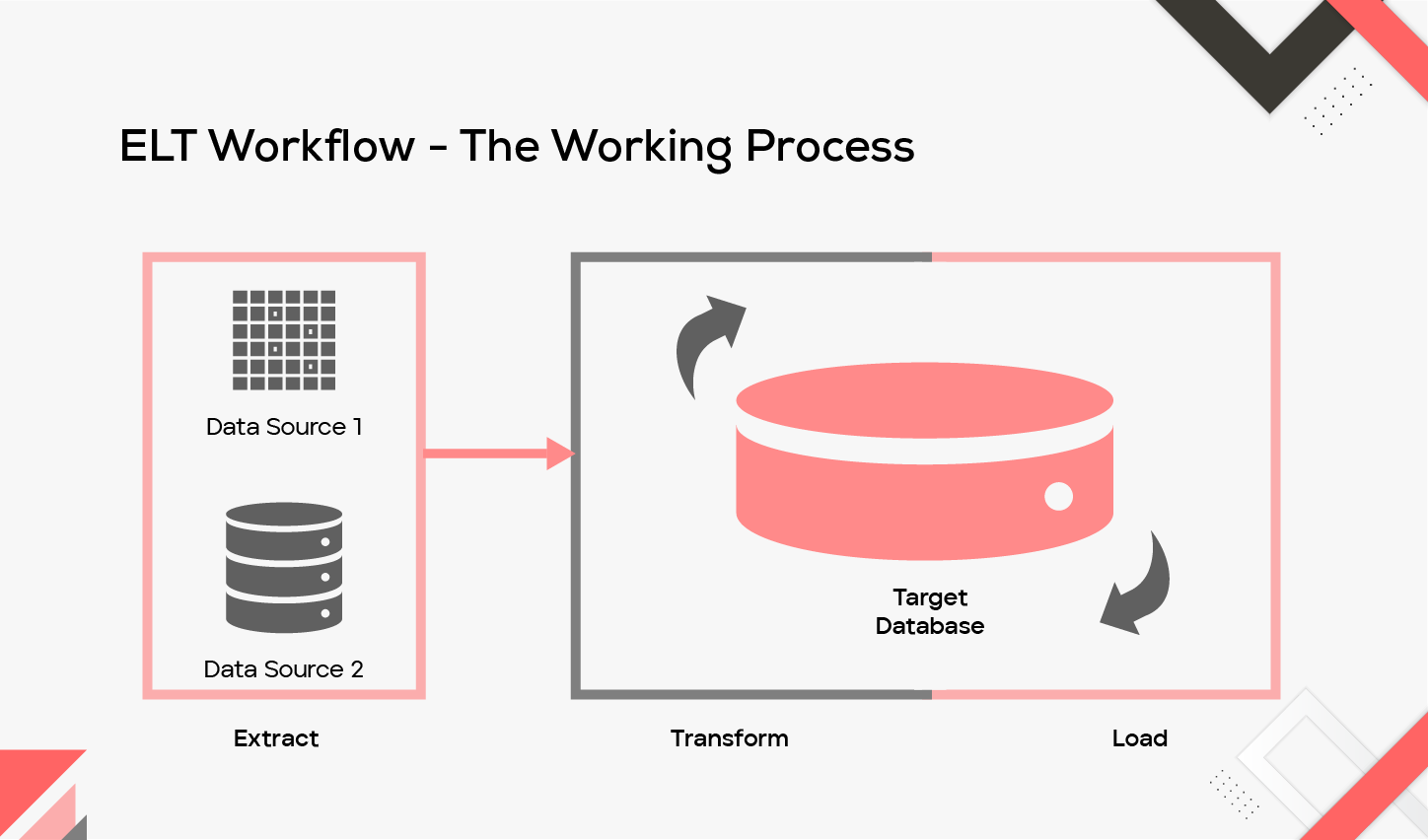
1. Extract
In both ways, the extraction steps work the same. Here, the raw data types are collected and moved to a staging place.
2. Load
The ELT and ETL vary during this step. ELT collects the raw data and sends it together to the storage system. The time between data collection and delivery is eventually reduced in the load stages.
3. Transform
During the transformation phase, the target data warehouse is kept ready and made available for the customer. Though the initial cost of storage seems higher, it provides a wide range of information on time.
Advantages of ELT Approach
ELT is an evolution of traditional ELT systems designed to maximise the use of scalable and reasonably priced compute and storage resources offered by modern cloud data warehouses.
Let’s now discuss the advantages of the ELT approach.
1. Ease of Maintenance
Since businesses do not invest in storage, the need for frequent maintenance is low and the ELT service offered by the organization takes care of the maintenance process.
2. Faster Data Loading
One of the biggest advantages is that the teams can load large raw data within a limited time. Organizations dealing the big data, find it useful as it is easy to analyse.
3. Wide Range of Analytics Options
To gain valuable insights, businesses store large raw data both in limited as well as advanced transformations. In the case of ETL, this case is not possible as it can only store pre-structured data.
Comparing ETL and ELT: What is the Difference?
Let’s now understand the key differences between ETL and ELT.
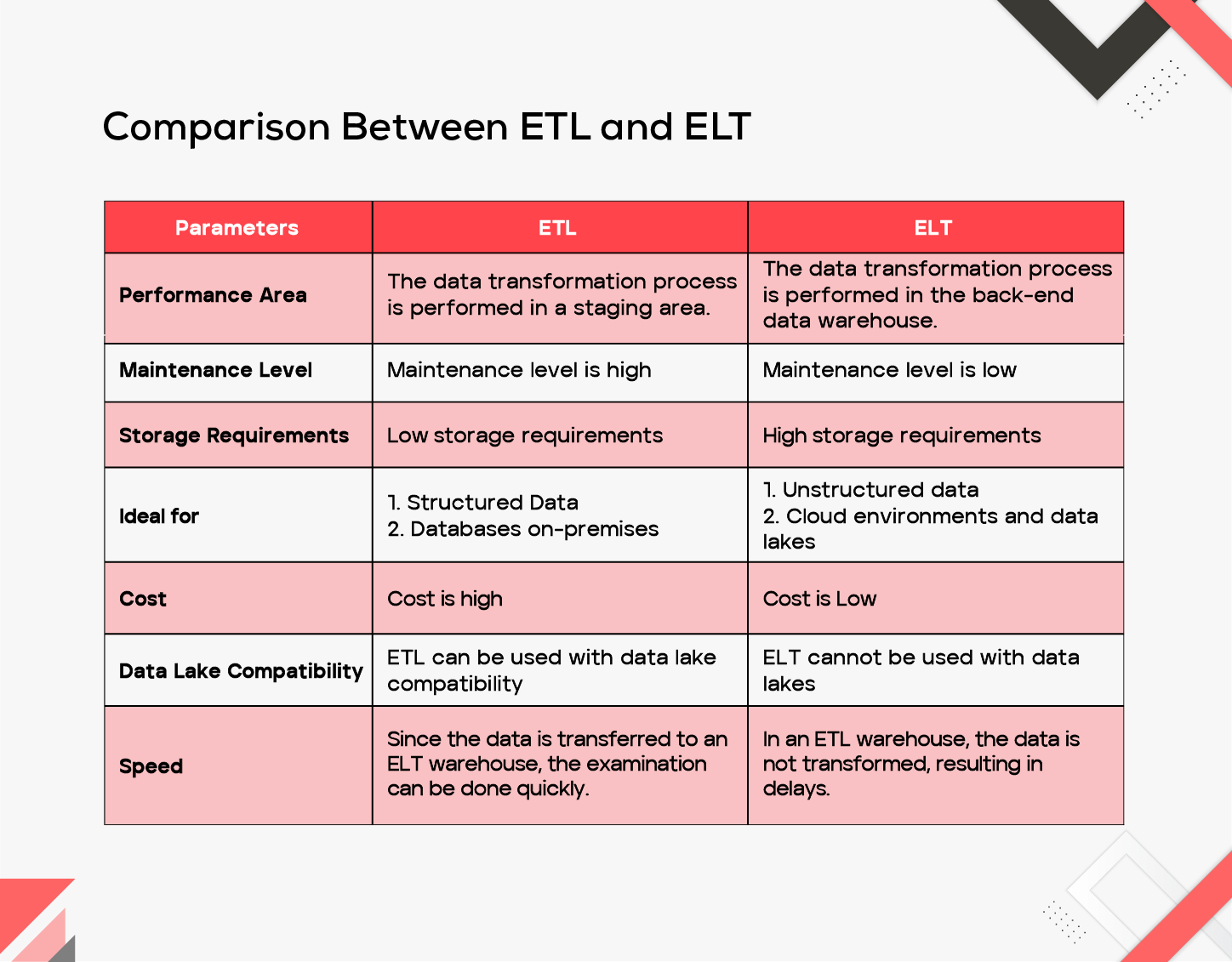
By using ELT and ETL, quality and integrity can be improved. While ETL’s greatest strength is its capacity to structure data for more in-depth analysis and examination, ELT’s greatest advantage lies in its speed and support for a variety of data types.
Unlocking the Potential of Top 5 ETL Tools
Now that we have a complete understanding of ETL and its advantages, let’s explore the potential of ETL tools.
ETL tools were developed to speed up and effectively extract data from various sources, transform it into a standardised and clean format, and load it into the target system.
1. AWS Glue
AWS Glue is widely used and offered by Amazon. The data from multiple sources is discovered, integrated and prepared for analytic use cases. The initial cost of data integration can be highly reduced with AWS Glue. Additionally, it can handle batch processing, streaming data, and both ETL and ELT scenarios.
2. AWS Data Pipeline
Data transfer between AWS services and on-site resources is made possible by the managed ETL service known as AWS Data Pipeline, which is well known for its scalability, reliability and flexibility. The platform also has a drag-and-drop option for user convenience and is also cost-effective.
3. Azure Data Factory
Microsoft offers Azure Data Factory, which is a cloud-based ETL service that lets users create workflows that transfer and alter data at scale. Also, it comprises interconnected systems and allows for the design and monitoring of data pipelines.
4. Stitch
Stitch is an extendible, ETL tool built especially for data teams. Data from various sources are extracted by the Stitch replication process, which then converts the information into a raw format and loads it into the target. ETL uses a variety of data connectors that include SaaS apps and databases, and the destinations include traditional data warehouses, storage platforms and data lakes.
5. Qlik Compose
ETL code and data warehouse designs are generated automatically by data warehouse solutions like Qlik Compose. This tool streamlines the automated code, which carries data from sources and transfers it to data warehouses. Further, workflow design can be used to schedule as well as to design.
Unleash the Power of Top 5 ELT Tools
ELT Tools are gaining popularity as a result of their capacity to manage massive amounts of unstructured data, large datasets required for efficient parallel processing and non-relational databases.
Here is the list of the top 5 ELT Tools that benefit your business.
1. Airbyte
The Airbyte tool is an open-source tool widely used by modern data teams. It quickly extracts data from sources like databases and web applications using pre-built connectors and loads it into target repositories through APIs and Airbyte. Moreover, it enables the monitoring of real-time alerts, notifications, and individual pipelines.
2. Fivetran
Fivetran is a replication tool for loading the data, offering a complete data integration process. It incorporates built-in version control, testing and documentation, along with data transformations. Additionally, it allows advanced analytics and database replication.
3. Blendo
Blendo offers prepared pipelines for the ELT’s extraction and loading phases. The extraction of raw data from various sources accelerates the entire process of data analysis. Blendo seamlessly integrates with Amazon Redshift, SQL Server, Snowflake and tools such as Sisense, Charito and Google Data Studio.
4. Hevo
With Hevo’s no-code, bi-directional data pipeline, data flow can be streamlined and automated. It provides a simple interface for data replication, cleaning and preparation and supports various SaaS ELT, streaming services and cloud platforms. Also, the flow of data can be modified, altered and observed in real-time.
5. Matillion
Mattilion is a leading ELT Tool for Amazon Redshift, Snowflake and Google BigQuery and is supported by an ELT architecture. It lies between Analytics tools and raw data and provides a drag-and-drop option.
In a Nutshell
Both ETL and ELT offer distinct solutions to your data integration needs. The best solutions depend on several factors including the type of storage, organizational needs and the type of data. Since data processing is important for an organization, it is necessary to choose them carefully. Despite some major differences between ELT and ETL, the majority of modern analytics prefer ELT because it significantly reduces the time required for data ingestion when compared to the traditional ETL process. Consequently, organizations can make decisions more quickly and with greater analytical flexibility.



